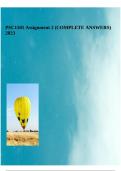PSC1501 Assignment 2 (COMPLETE ANSWERS)
2023
, 1.1 Classifying practical activities: Classifying practical activities refers to categorizing and organizing
different types of hands-on experiments and investigations conducted in a scientific setting. These
activities can be classified based on various criteria such as the skills they develop, the scientific concepts
they explore, or the equipment and materials required. By classifying practical activities, educators can
ensure a balanced and comprehensive approach to teaching practical science.
1.2 What is needed for practical science in the classroom: Practical science in the classroom requires a
few essential components. Firstly, it necessitates clear learning objectives and aligned curriculum that
integrate theoretical knowledge with hands-on experiences. Secondly, appropriate resources and
materials should be available, including scientific equipment, tools, chemicals, and consumables.
Moreover, access to safety guidelines and protocols is crucial to ensure the well-being of students. Lastly,
supportive classroom management and teacher guidance are essential to facilitate effective
implementation and supervision of practical science activities.
1.3 Classroom versus laboratory: The distinction between a classroom and a laboratory lies in their
primary purposes. A classroom typically serves as a general learning space where theoretical knowledge
is imparted and discussions take place. It provides a setting for lectures, demonstrations, and group work.
On the other hand, a laboratory is specifically designed for practical activities and experiments. It is
equipped with specialized apparatus and equipment, allowing students to engage in hands-on scientific
investigations and apply theoretical concepts in a controlled environment.
1.4 Equipment for practical science in the classroom: Equipment for practical science in the classroom
encompasses a range of tools and apparatus that facilitate hands-on learning experiences. This can
include basic laboratory items such as beakers, test tubes, pipettes, and thermometers, as well as
specialized equipment specific to certain scientific disciplines. The selection of equipment depends on the
nature of the experiments planned and the level of complexity desired. It is important to ensure that the
equipment is appropriate for the age group and skill level of the students.
1.5 Supporting practical science in the classroom: Supporting practical science in the classroom involves
creating an environment that fosters active learning and inquiry. This can be achieved by providing clear
instructions and guidance to students, encouraging them to think critically and ask questions during
practical activities. Teachers can also offer support by providing relevant background information,
demonstrating techniques, and facilitating discussions to help students make connections between theory
and practice. Additionally, access to resources such as reference materials, online databases, and
scientific literature can further support students' understanding and engagement in practical science.
1.6 Safety in the classroom and environmental impact outside it: Safety in the classroom refers to the
precautions and measures taken to ensure the physical well-being of students during practical science
activities. This includes following safety protocols, providing appropriate protective equipment (e.g.,
goggles, lab coats), and instructing students on the safe handling and disposal of chemicals and
materials. Furthermore, considering the environmental impact outside the classroom involves promoting
responsible practices, such as proper waste management and recycling, to minimize any negative
consequences on the environment resulting from scientific experiments or laboratory activities.
1.7 Washing up, tidying, maintenance – the role of learners: The role of learners in washing up, tidying,
and maintenance involves taking responsibility for maintaining a clean and organized laboratory
environment. Students should actively participate in cleaning and tidying up after practical activities,
ensuring that equipment and materials are properly stored and returned to their designated places.
Additionally, learners can contribute to the maintenance of equipment by following guidelines for its proper
use, reporting any damages or malfunctions promptly, and assisting in routine maintenance tasks as
instructed by the teacher.
1.8 Practical science on a shoestring budget: Practical science on a shoestring budget refers to
conducting hands-on scientific activities and experiments with limited financial resources. It involves
finding cost-effective alternatives, utilizing readily available materials, and adapting experiments to fit
within budget constraints. This may include




